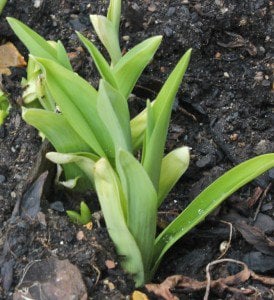 So come on March, are you coming in as a lion or lamb? With hemerocallis rapidly emerging, species tulips, Tulipa humilis already in flower and Sambucus ‘Black Lace’ coming slowly into bud, I am hoping for a lamb. Whatever March decides, it is going to take a while for the soil to warm, particularly on heavier soils like my Hertfordshire clay. Raised beds or lighter soils like my vegetable plot can be readied for early sowings by lightly forking over the ground, then covering it with plastic sheet so the sunshine warms the soil. Rather than leaving it to chance, a soil thermometer is a worthwhile investment and reduces the chances of losing seeds through rotting. Once the soil has warmed, early peas, like ‘Meteor’ and ‘Feltham First’, bolting resistant vegetable varieties, like the beetroot ‘Bolthardy’, carrots like ‘Early Nantes’ can be sown directly into the ground. A useful alternative is to raise them in modules in the greenhouse or sunny windowsill for planting outdoors when the soil is warms later in the month.
So come on March, are you coming in as a lion or lamb? With hemerocallis rapidly emerging, species tulips, Tulipa humilis already in flower and Sambucus ‘Black Lace’ coming slowly into bud, I am hoping for a lamb. Whatever March decides, it is going to take a while for the soil to warm, particularly on heavier soils like my Hertfordshire clay. Raised beds or lighter soils like my vegetable plot can be readied for early sowings by lightly forking over the ground, then covering it with plastic sheet so the sunshine warms the soil. Rather than leaving it to chance, a soil thermometer is a worthwhile investment and reduces the chances of losing seeds through rotting. Once the soil has warmed, early peas, like ‘Meteor’ and ‘Feltham First’, bolting resistant vegetable varieties, like the beetroot ‘Bolthardy’, carrots like ‘Early Nantes’ can be sown directly into the ground. A useful alternative is to raise them in modules in the greenhouse or sunny windowsill for planting outdoors when the soil is warms later in the month.
It’s also time to a good time to go slug and snail hunting, setting traps, hand picking or using ferric phosphate based slug pellets. Reducing numbers early in the year controls populations of later generations. Pay particularly attention to young shoots of Hosta’s, which are emerging through the soil, we all know how they are attracted to them like a Michelin star menu and the young shoots of hemerocallis, which are looking particularly succulent, as the picture shows. It is also worth looking out for early infestations of aphids, too, particularly in the greenhouse. These can be squashed by hand, taking care not to damage young growth, or controlled using organic sprays based on soft soap or plant oils. Alternatively, encourage natural predators like blue tits, which are particularly effective when feeding their young as they will be within a few weeks.
It’s also a good time to weed borders and pots before they flower and set seed, fast growing annual weeds are particularly effective at creating a rapid return and a weed free garden now can save you lots of work later in the season. One ‘Chickweed’ plant produces up to 2000 seeds per plant and completes its life cycle from germination to seed dispersal, in seven weeks! Later in the month when the soil is moist and warm, mulch your newly weed free borders with plenty of well rotted organic matter, to suppress weed growth, keep the soil moist and warm and protects the roots of herbaceous plants or shrubs.
It is also time to prune ‘Dogwood’s’ grown for their winter stems. Young stems, have the best colour, so cut back the old stems to within a few centimetres of the base in March before bud burst. Cornus sanguinea ‘Midwinter Fire’ which is less vigorous should be pruned every other year; alternatively, cut back half of the stems every year. Once they have been cut back, give them a feed with slow release general fertiliser, mulch and water if needed in spring to encourage lots of vigorous young growth for next year’s display! Happy Gardening. Matt.










